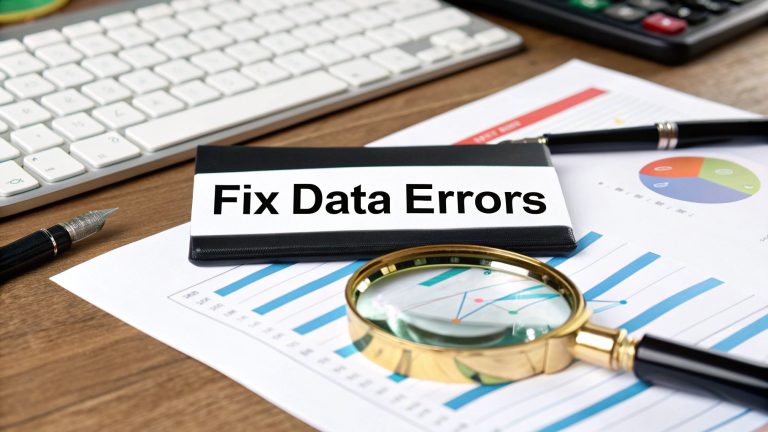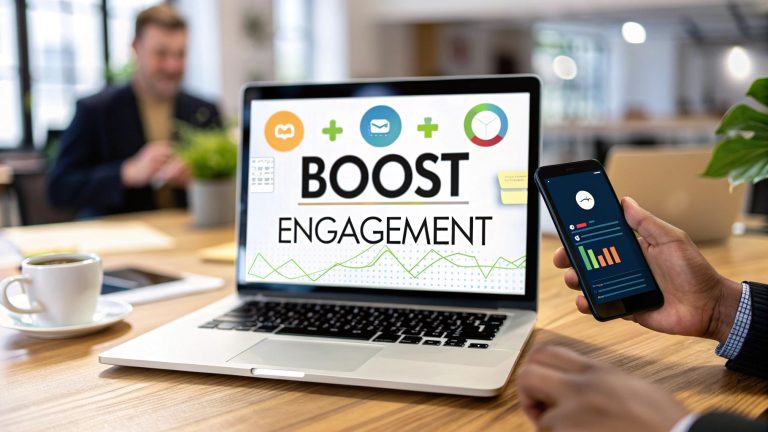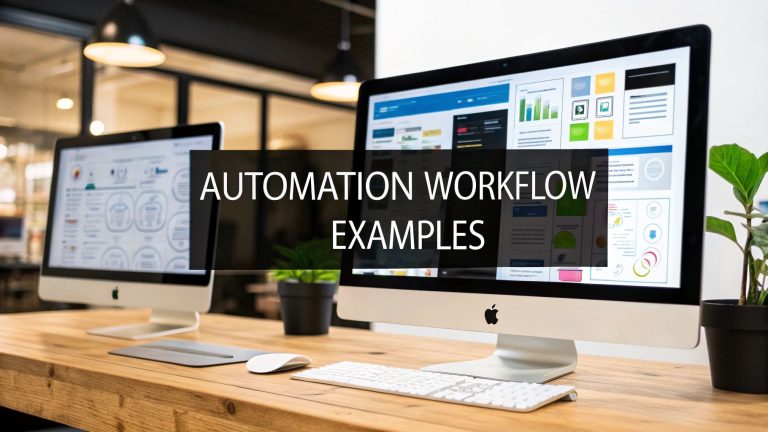get leads network marketing: 5 Modern Prospecting Tactics
If you want to get leads for network marketing, you have to make a fundamental shift. Stop hunting for prospects and start becoming a magnet that attracts them.
This means leaving outdated, cringe-worthy tactics behind—like the dreaded "three-foot rule"—and building a real online presence that pulls in people who are already searching for what you offer.
The Modern Playbook for Network Marketing Leads
Let's be real for a second. The old-school methods of prospecting are just plain exhausting.
Cornering friends and family at holiday dinners or sliding into a stranger’s DMs with a copy-pasted script isn't a sustainable business model. It’s a fast track to burnout, awkward relationships, and painfully inconsistent results. This approach makes you a hunter, always chasing the next person.
The biggest change you can make for long-term success is to stop being the hunter and become a value-driven magnet. This whole concept is often called attraction marketing, and it’s all about creating a system that brings people to you, even when you’re not actively working.
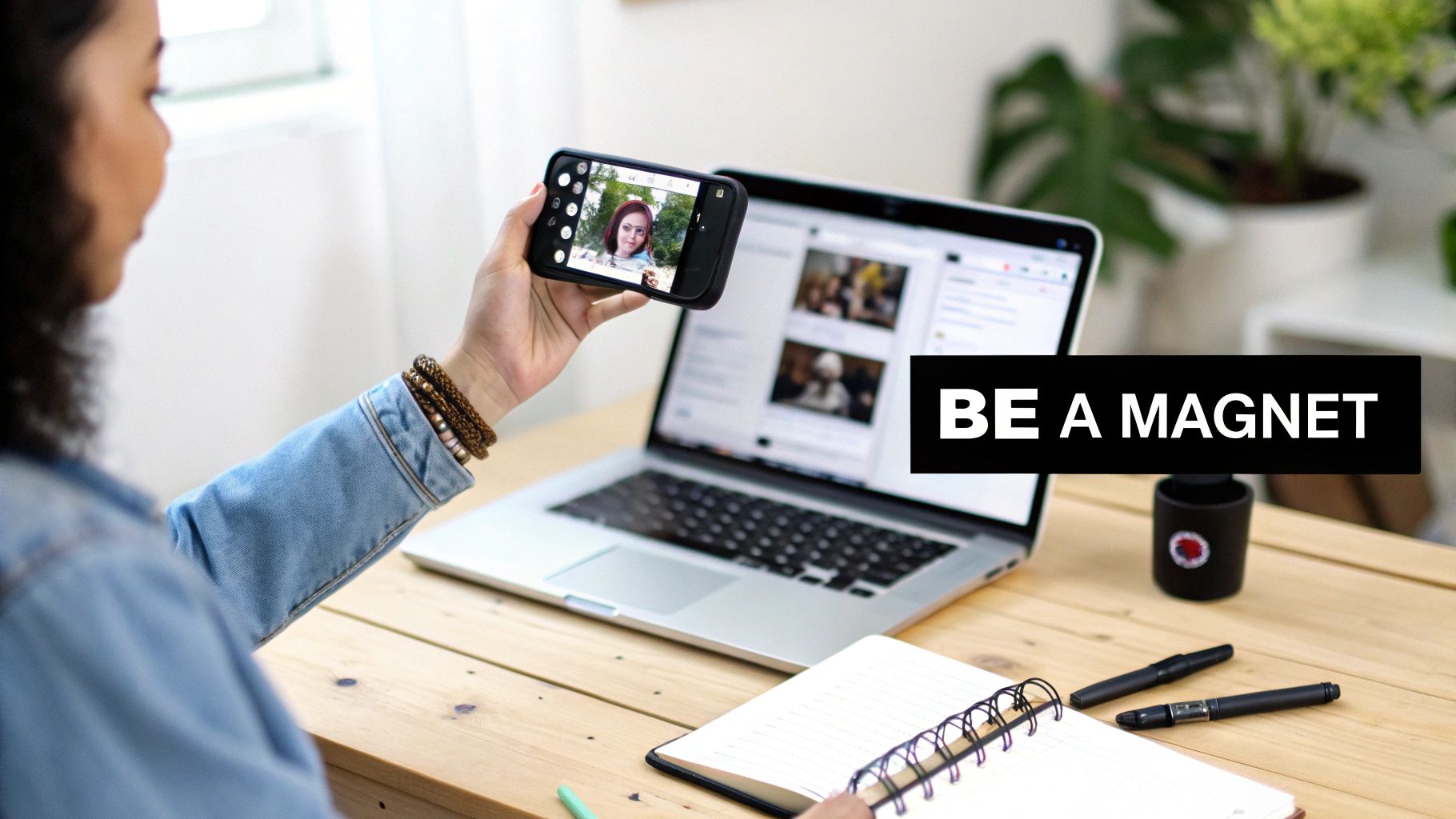
Why Attraction Marketing Works
Instead of leading with your product or pitching the business opportunity right away, you lead with value. Simple as that.
You do this by sharing what you know, offering solutions to common problems your audience faces, and building a genuine personal brand. When you consistently put helpful content out there, you naturally become a trusted authority in your space.
This completely flips the script. Prospects start seeing you as a helpful resource, not just another salesperson.
The goal is to make people feel like they discovered you, not that you hunted them down. This mindset shift is the single most powerful change you can make to get leads for network marketing consistently.
This modern approach isn't about ditching relationships; it's about starting them the right way. You'll build authentic connections with people who are actually looking for solutions. This automatically pre-qualifies your leads, making conversations feel natural and closing sales way smoother.
Before we jump into the specific tactics, it’s worth taking a moment to see just how different the old and new methods really are.
Old School Prospecting vs Modern Lead Generation
Understanding this contrast makes it crystal clear why a strategic update is non-negotiable for anyone serious about growing their network marketing business today.
| Method | Traditional Approach (The Hunt) | Modern Approach (The Magnet) |
|---|---|---|
| Outreach | Interrupting people with unsolicited pitches (cold calls, DMs). | Creating valuable content that solves problems and attracts interested people. |
| Audience | Friends, family, and anyone within a three-foot radius. | A targeted, ideal audience that is actively searching for your solutions. |
| Positioning | You are positioned as a salesperson trying to make a sale. | You are positioned as an expert and a helpful guide. |
| Scalability | Limited by the number of people you can personally contact. | Highly scalable through digital content that works for you 24/7. |
| Sustainability | High risk of burnout and alienating your personal network. | Builds a long-term business asset (your brand) that generates leads on autopilot. |
The comparison really says it all, doesn't it?
While the traditional "hunt" relies on pure hustle and volume, the modern "magnet" approach is built on strategy, value, and creating a sustainable system. This foundation is exactly what you need to get leads network marketing professionals can count on, and it sets the stage perfectly for the actionable strategies we're about to dive into.
Generate Leads Organically on Social Media
Let's kill a myth right now: blasting your product link in every Facebook group you stumble into doesn't work. It's not just ineffective—it's the fastest way to get ignored, blocked, and totally burn out your motivation.
If you want to get leads network marketing pros can actually build a business with, you have to start treating your social media profile like a prime piece of real estate, not a billboard on the side of the highway.
Think of your Facebook or LinkedIn profile as your digital storefront. It needs to be clean, inviting, and designed to attract your ideal prospect. It should build curiosity and make it incredibly easy for them to connect with you. This isn't about being pushy; it's about positioning yourself as the go-to problem-solver people want to talk to.
Transform Your Profile into a Lead Machine
Before you send a single message, your profile needs to do the heavy lifting for you. Trust me, people will check you out before they reply to your message or accept a friend request. Make sure what they find positions you as a credible, helpful expert, not just another salesperson.
Here are a few quick but critical tweaks you can make today:
- Professional Profile Picture: Use a clear, high-quality headshot. You should look friendly and approachable. No sunglasses, no blurry vacation photos, and definitely no pictures of your dog (no matter how cute they are).
- Benefit-Driven Bio: Ditch the "Distributor at [Company Name]" line. Instead, tell people who you help. Something like, "Helping busy moms find natural wellness solutions without the guesswork" is far more compelling.
- Strategic Cover Photo: This is your biggest piece of visual real estate—use it! Communicate your brand's vibe or add a simple call to action, like an arrow pointing to a link for your free resource or community group.
Making these small changes shifts the dynamic immediately. When someone lands on your profile, they don't see a walking advertisement. They see a person dedicated to helping others, and that's infinitely more inviting.
Master the Art of Value-First Content
The real engine of organic lead generation is content that serves your audience before you ever ask for anything in return. Your goal is to create posts that educate, inspire, or entertain your ideal prospect, solidifying your status as a go-to resource in your niche.
Get inside your target audience's head. What are their biggest headaches? What goals keep them up at night? Your content should be the answer they're looking for.
The most effective organic strategy is rooted in creating authentic curiosity. When people see you consistently offering solutions and insights, they naturally start to wonder what you do and how you can help them more directly.
Stuck on ideas? Try these:
- Share a personal story about how you overcame a problem your audience is facing right now.
- Offer a quick tip or a "how-to" that gives them an immediate small win.
- Go live for a Q&A session and answer the most common questions you get.
- Post a simple poll or an engaging question to get a conversation started in the comments.
When you lead with value, you attract people who are genuinely interested in what you have to say. This makes the transition from a public post to a private conversation feel completely natural and seamless. For a deeper dive, check out our guide on effective social media lead generation techniques.
The Non-Spammy Approach to Direct Messages
Okay, you’ve got your profile dialed in and you're posting great content. Now it's time to start having one-on-one conversations. This is where most network marketers drop the ball. Ditch the copy-paste script that screams, "I want to sell you something!"
Instead, just be a real person. Lead with genuine interest. Your goal is to build rapport, not to launch into a pitch. Find something you have in common or mention a recent post of theirs that you genuinely enjoyed.
A simple, non-threatening opener could be:
"Hey [Name], I saw your comment on that post about [Topic] and really resonated with what you said. Just wanted to connect!"
From there, just ask questions. Get curious. Find out about their goals, their frustrations, and what they're looking for. Once you actually understand their needs, you can figure out if your product or opportunity is even a good fit in the first place. This consultative approach turns a cold outreach into a warm, helpful conversation.
And don't forget about other platforms. While Facebook is king for B2C, LinkedIn is a powerhouse for certain niches, especially in the B2B space. The numbers don't lie: an incredible 89% of B2B marketers use LinkedIn to source prospects. Research shows it's a staggering 277% more effective for lead generation than Facebook or X, with Lead Gen Form conversion rates hitting 13%—miles above the industry average. You can dig into more of these powerful lead generation statistics on seoprofy.com. The key is knowing where your ideal audience hangs out and focusing your energy there.
Automate Your Follow-Up and Nurture Leads
Getting a lead is just the starting line. The real magic—and the real money—is made in the follow-up. But if you're trying to manually track every new contact, send personalized messages, and remember who needs what next, you're setting yourself up for a headache. This is where promising leads go to die: lost in the chaos of a messy follow-up plan.
Smart automation is the answer. It’s about building simple systems that do the heavy lifting for you, making sure no one ever slips through the cracks. This frees you up to do what you do best: have real, meaningful conversations with the people who are most interested.
The Power of Automated Nurturing
Picture this: someone downloads your free PDF on clean eating. Instead of you setting a reminder to email them next week, an automated system instantly sends them a welcome message. Two days later, it sends a related recipe. A few days after that, it shares a quick success story from another customer.
That's lead nurturing on autopilot. You're building trust and providing value without lifting a finger after the initial setup.
And the data backs this up. A staggering 80% of users report an increase in leads when using marketing automation. On top of that, 34% of marketers credit automation for improving both lead generation and nurturing. When you consider that nearly 70% of marketers already use email, adding a layer of automation is the most logical next step to scale your efforts.
Think of the flow from social media to your system like this:
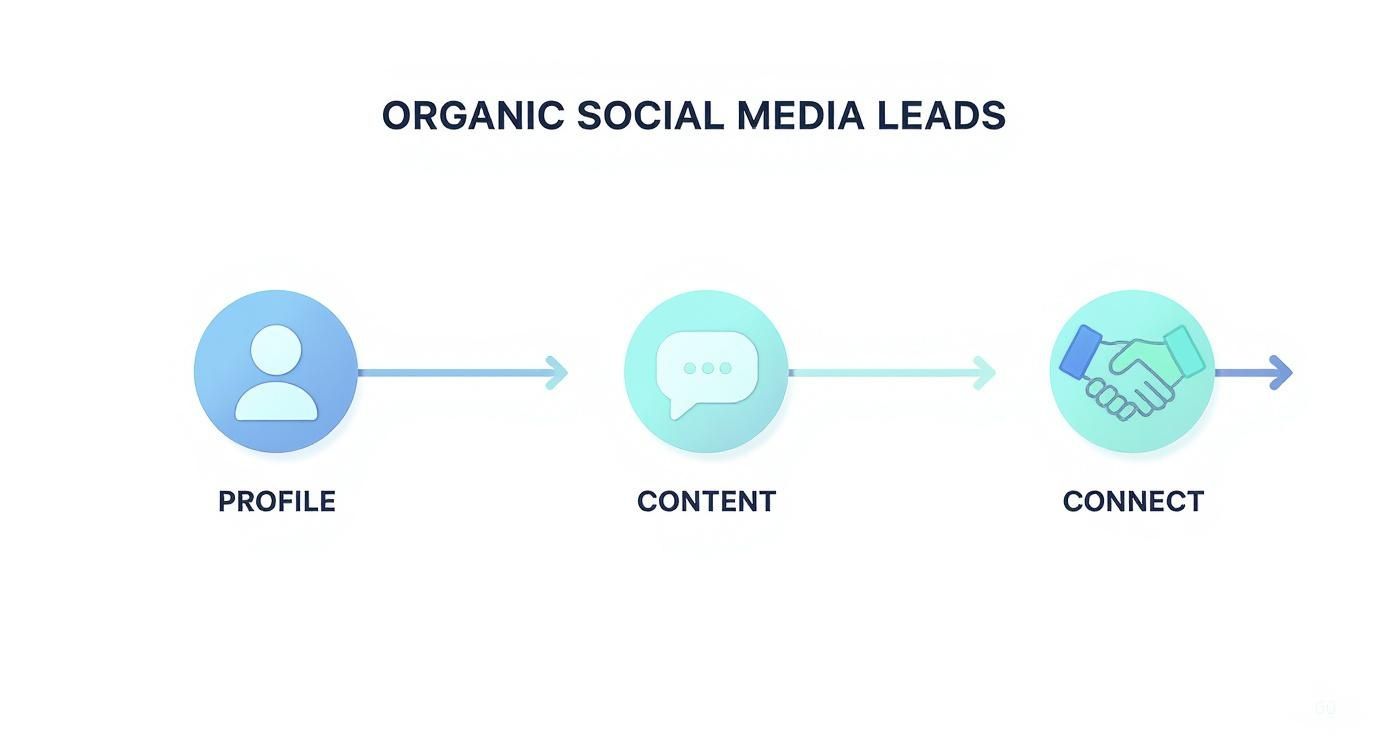
It all starts with an optimized profile and great content, which naturally leads to connections. Those connections then get plugged right into your automated follow-up sequences.
Creating Your First Automated Sequence
Getting started with automation doesn't mean you need complicated, expensive software. Most modern email marketing platforms have simple automation features that are perfect for network marketers. The key is just to map out a logical journey for your new leads.
Your first automated email sequence could be as simple as this:
- Email 1 (Immediate): Delivers the freebie (your PDF guide) along with a warm welcome. Keep it short, introduce yourself, and let them know what to expect.
- Email 2 (2 Days Later): Share a quick, useful tip related to the guide. This shows you know your stuff and gives them another win.
- Email 3 (4 Days Later): Tell a personal story or share a customer testimonial. This is how you build a real connection and social proof.
- Email 4 (7 Days Later): Gently introduce your product or opportunity as the solution to their problem. Think of it as a soft invitation, not a hard sell.
This simple four-email sequence works around the clock to warm up your prospects, building a relationship long before you ever ask for a sale. For a deeper dive, check out our guide on building an automated lead nurturing system.
Tools for Simple Automation
You don’t have to be a tech genius to make this happen. Several tools are built to make automation easy for everyone.
Email Marketing Platforms: Services like Mailchimp, ConvertKit, or AWeber all have user-friendly automation builders. You can create simple "if-then" rules, like "if someone clicks a link about weight loss, add a 'weight loss interest' tag to their profile."
Chatbots: A simple chatbot on your Facebook page can be a huge help. It can answer common questions, qualify prospects, and even book calls for you—all while you’re busy doing other things.
The point of automation isn't to replace human connection. It's to handle the repetitive stuff so you have more time for genuine, one-on-one conversations with your best leads.
By setting up these systems, you’re building an asset that nurtures relationships at scale. It ensures every single lead you generate gets the attention they need to move forward. To see how others are doing this effectively, explore these fantastic lead nurturing campaign examples. This simple shift turns your follow-up from a daily chore into a powerful, automated engine for your business.
Scale Your Reach with Targeted Facebook Ads
Organic outreach is a solid foundation, but it’s like taking the scenic route—steady, but slow. When you're ready to really crank up the heat and build a predictable, scalable flow of leads, it's time to get serious about paid advertising.
Facebook Ads are the perfect tool for the job. They give you an incredible opportunity to get your message directly in front of the exact people who need your solution.
This isn't about dropping a ton of cash. It's about being strategic. A small, consistent ad budget can become a reliable machine that helps you get leads network marketing professionals can truly build a business on. We're moving beyond randomly boosting posts and into the world of targeted campaigns that actually deliver.
Pinpointing Your Perfect Audience
The real magic of Facebook Ads lies in its insane targeting capabilities. You can go way beyond broad demographics and drill down to the specific interests, behaviors, and lifestyles of your ideal prospect. This is where you get hyper-specific and make every ad dollar count.
Forget just targeting "women ages 30-50." You need to think deeper. Who is this person really?
- What are her interests? Maybe she follows health influencers like Dr. Mark Hyman or Dave Asprey. Or perhaps she's in groups dedicated to keto diets or holistic living.
- What are her behaviors? Has she recently bought fitness gear or organic products online?
- What are her demographics? Is she a college-educated mom who lives in a suburban area?
By layering these targeting options, you create a laser-focused audience that is far more likely to connect with your message. You’re no longer shouting into a crowded room; you’re having a one-on-one conversation with someone who is already looking for what you offer.
Crafting Ads That Stop the Scroll
Let's be real: the Facebook newsfeed is a busy place. Your ad has to grab attention fast. This boils down to two things: a compelling visual and copy that sparks curiosity. Generic stock photos and boring headlines are a complete waste of money.
Your ad needs to speak directly to your audience's pain points and offer a clear, valuable solution right away.
For example, ditch the "Join My Team!" ads. Instead, lead with something that offers real value upfront.
Ad Idea: A Free Webinar
- Headline: "Tired of Mid-Day Energy Slumps? 5 Natural Ways to Boost Your Focus."
- Visual: A quick video of you sharing one of those tips.
- Call to Action: "Register for the Free Webinar"
Ad Idea: A Sample Pack
- Headline: "Discover the Clean Protein Smoothie That Actually Tastes Amazing."
- Visual: A vibrant, high-quality photo of the smoothie.
- Call to Action: "Claim Your Free Sample Pack"
See the difference? These ads work because they lead with value. You’re not asking for a huge commitment—you’re offering a free resource that solves a real problem. This is how you start building trust and turn a cold prospect into a warm lead.
For a deeper dive into campaign structure, check out our complete guide on Facebook Ads best practices.
The most successful ads don't feel like ads at all. They feel like a helpful solution that appeared at just the right time. Your goal is to be the answer to a question your prospect is already asking themselves.
Demystifying the Facebook Pixel and Retargeting
The Facebook Pixel sounds technical, but it’s your secret weapon for making your ad spend incredibly efficient. It's just a small piece of code you add to your website or landing pages. Its job is to track who visits your pages, which lets you "retarget" them with specific ads later.
Ever look at a pair of shoes online, then see ads for those exact shoes following you around the internet? That’s retargeting.
Here’s how it works in practice:
- Someone clicks your webinar ad but gets distracted before they finish signing up.
- The Pixel makes a note of their visit.
- You can then set up a second, low-cost ad campaign that is only shown to people who visited the registration page but didn't complete it.
That follow-up ad could say something simple like, "Hey, did you forget to save your spot? Only a few seats left!" This is a super warm audience that has already shown interest, making them much more likely to convert. Retargeting is how you scoop up the leads that would have otherwise slipped away, massively lowering your overall cost per lead.
As you start to scale with ads, it's critical to use powerful Facebook analytics tools for marketers to get a clear picture of what's working. Understanding that data is what separates guessing from growing.
Create a Referral System That Works for You
Your most enthusiastic customers are your secret sales force, just waiting to be activated. But here's the thing: most network marketers never tap into this goldmine because they don’t have a simple, repeatable system. They're just hoping for random word-of-mouth instead of building a predictable referral engine.
Let's fix that. A structured referral program turns happy customers into a consistent source of incredibly warm leads—people who are already primed to trust you because their friend does.
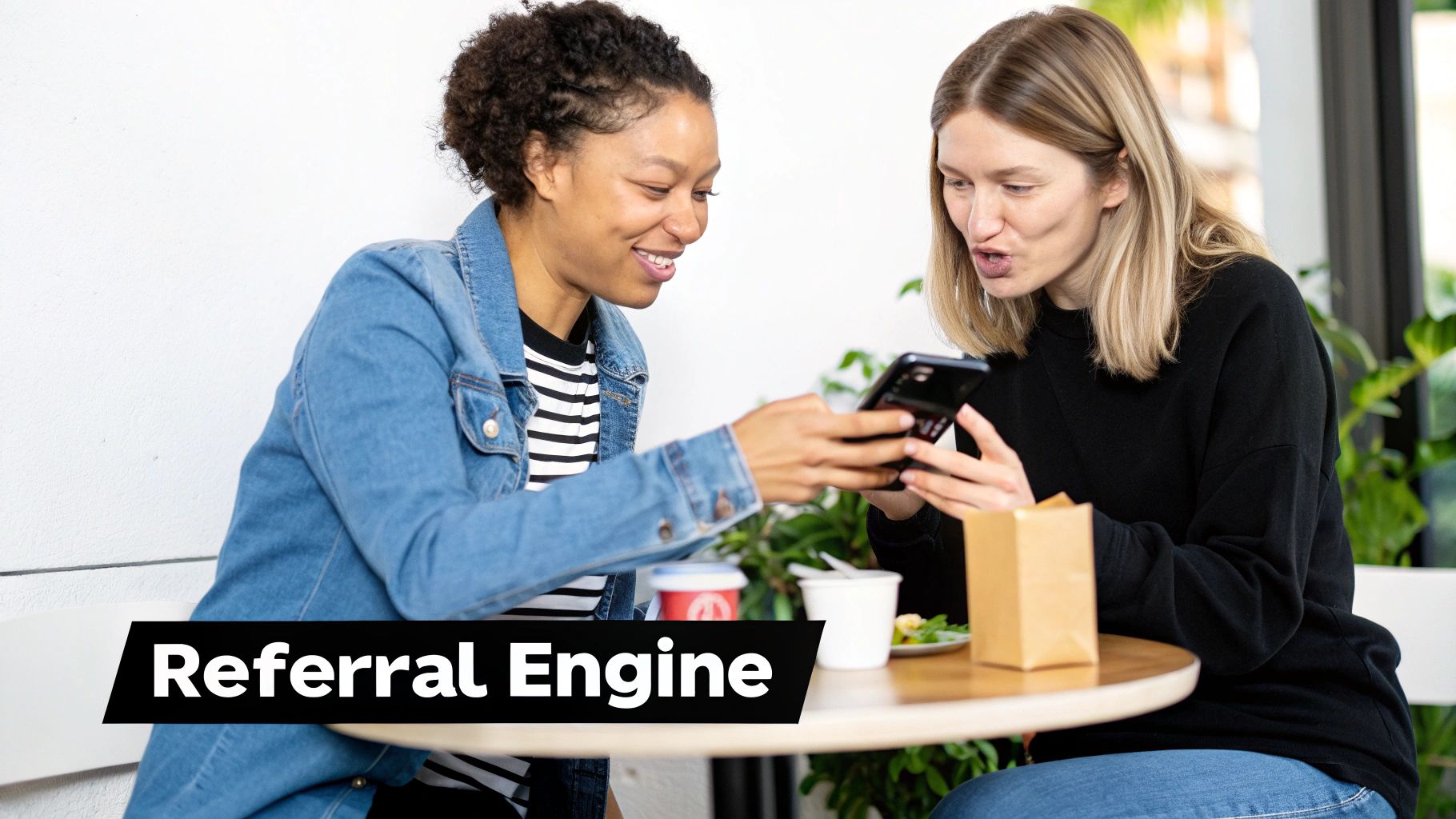
Design Incentives People Actually Want
First things first, you need an incentive that genuinely motivates people to share. While cash is an option, it's often not the strongest pull. Get creative and think about what your audience would truly value.
Here are a few ideas to get you started:
- Product Credits: Offering a discount or credit toward their next purchase is a classic win-win. It rewards them for sharing and drives repeat business for you.
- Exclusive Access: Make them feel like insiders. Grant them access to a VIP community, an early look at new products, or a special training session. Scarcity and exclusivity are powerful motivators.
- Tiered Rewards: Gamify the experience. Maybe one referral gets a free sample, three referrals unlocks a 25% discount, and five referrals earns them a special gift. This encourages repeat sharing.
The key is to offer something that feels substantial and is directly tied to your brand. A reward that reinforces the value of what you offer will always beat a generic gift card.
Master the Timing of Your Ask
Knowing when to ask for a referral is just as important as knowing how. Bad timing feels awkward and pushy. Good timing feels like a natural next step. The absolute best time to ask is right after a moment of high satisfaction.
The "peak-end rule" suggests people judge an experience based on how they felt at its most intense point and at its end. Capitalize on these positive peaks to make asking for a referral feel natural and welcome.
Keep an eye out for these golden opportunities:
- Right After a Positive Testimonial: A customer DMs you or posts about how much they love a product? That's your cue. Thank them profusely, then gently make your ask.
- When They Reorder: A repeat purchase is the ultimate signal of a happy customer. It's the perfect, low-friction moment to mention your referral program.
- After They Share a Success Story: Did your product help them hit a specific goal? Celebrate that win with them, then ask if they know anyone else who could use the same results.
Make Referring Unbelievably Simple
Even with the world's best incentive, nobody will refer if it's a hassle. Your job is to remove every single ounce of friction. The entire process should take them less than 60 seconds.
Use simple tools to make sharing a breeze:
- Personalized Referral Links: Give each person a unique, trackable link they can easily copy and paste into a text, email, or social media post.
- Pre-Written Templates: Don't make them think. Give them a simple script they can tweak. For example: "Hey! I've been using [Product Name] and it's been a game-changer for my energy levels. Thought you might like it too! Here's a link for a discount."
When you systematize word-of-mouth, you transform it from a happy accident into a reliable pillar of your lead generation strategy.
Your Questions on Network Marketing Leads Answered
Jumping into online lead generation can feel like you're learning a whole new language. You have the game plan, but questions always pop up when the rubber meets the road. I get it. This section is all about tackling the most common roadblocks I see network marketers hit, with direct advice to get you moving forward.
How Much Should I Spend on Ads When Starting?
You absolutely do not need a massive budget to get started. In fact, you shouldn't.
A smart, effective starting point is just $5 to $10 per day. The goal here isn't to get hundreds of leads overnight; it's to gather crucial data. Think of it as a small, controlled experiment.
Run this tiny test for about 5 to 7 days. That’s long enough to see which ad visuals, copy, and audience targeting are actually getting clicks and leads. Your mission is simple: prove your ad concept works before you pour more money into it.
Once you find that winning combination that brings in leads at a price that makes sense, you can confidently start bumping up your daily budget. Just keep a close eye on your Cost Per Lead (CPL)—that's the number that tells you if your campaigns are truly profitable.
Can I Truly Get Leads Without Being Pushy?
Absolutely. In fact, the entire strategy in this guide is built on that very principle. The biggest hurdle is mental. You have to shift from a mindset of "selling" to one of "serving." When you genuinely aim to help people solve a problem, the pushiness just melts away.
Instead of leading a conversation with your company or a product link, lead with pure value.
- Share helpful tips that solve a problem in your niche.
- Create content that answers a real, nagging question for your ideal audience.
- Have genuine, curious conversations. Ask people about their struggles and goals.
When you establish trust first, introducing your product becomes the natural next step—a solution to a problem you've already discussed together. It feels like a helpful suggestion from a friend, not a cold pitch from a stranger.
A mindset shift I had to make was to stop trying to convince prospects why they should join me. Instead, start thinking like you're the one interviewing them to see if their goals and dreams qualify for your time.
This simple flip positions you as the expert with the solution, which naturally helps you get leads network marketing professionals can build a real business on.
What Is the Single Most Important Metric to Track?
Likes, shares, and comments are nice, but they're vanity metrics. They feel good, but they don't pay the bills. The single most critical metric you must track is your Cost Per Qualified Lead.
A qualified lead is more than just a name and an email. It’s someone who fits your ideal customer profile perfectly and has shown real, high-level interest in what you offer.
Think about it this way: it is far better to generate 10 high-quality leads for $50 than it is to get 100 unqualified leads for the same price. The first group is filled with potential partners; the second is a time-wasting dead end.
This one number tells you exactly which of your marketing efforts are delivering a real return on your investment. It cuts through the noise and shows you precisely where to focus your time, energy, and money for the best results.
How Long Until Organic Strategies Start Working?
Organic marketing is about building momentum. It’s a marathon, not a sprint. To see a predictable, consistent flow of people reaching out to you, you need to commit to being consistent for at least 90 days.
This isn't a passive waiting game. It requires active, daily effort in the beginning.
- Content: Post valuable, problem-solving content several times per week. Be the go-to person for your topic.
- Engagement: Get into authentic, non-salesy conversations every single day. Comment, ask questions, and be a real person.
The initial grind you put in builds a powerful asset: your personal brand and authority. Over time, that asset will continue to attract leads with less and less active work from you. The payoff for that early consistency is a truly sustainable business that doesn't live and die by paid ads.
Ready to stop manually downloading leads and start converting them faster? LeadSavvy Pro automates your entire Facebook lead capture process, sending new prospects directly to your Google Sheet or CRM in real-time. Start for free and see the difference.


